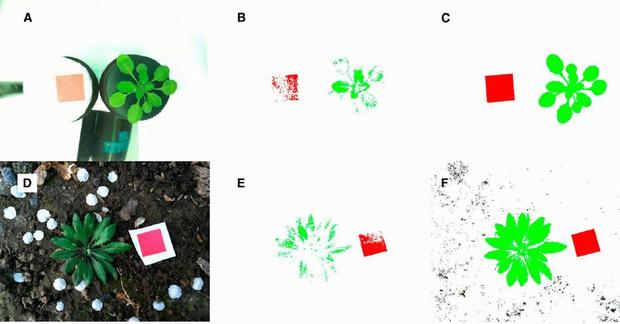If you want to do something more practical with your phone than playing Angry Birds and reading email you won't reply to until you get to a computer, researchers at U.C. Davis have created Easy Leaf Area, which allow users to accurately measure leaf area from digital images in seconds.
Leaf measurements are often critical in plant physiological and ecological studies, but traditional methods have been time consuming and sometimes destructive to plant samples.
"It has always been a challenge to measure leaf surface area without damaging the plants or spending long hours in the lab, so I decided to attempt to write software to automatically measure leaf and scale area from smartphone images," explains Hsien Ming Easlon, a researcher at UC Davis and one of the developers of Easy Leaf Area. "Leaf area measurements are essential for estimating crop yields, water usage, nutrient absorption, plant competition, and many other aspects of growth."
Raw and processed photographs of Arabidopsis . Unprocessed images (A, D), images after greenest and reddest pixel selection (B, E), and images after fi nal automated processing (C, F) with the delete background option selected. Areas recolored green were identifi ed as leaves and areas recolored red were identifi ed as calibration area. Darker nongreen components in the fi nal image (F) fi t pixel threshold and color ratio criteria, but were below the minimum component size, and so were not included in leaf area calculations.
DOI:10.3732/apps.1400033
The digital images he uses are taken with the Apple IPhone 4, but any current smartphone camera or digital camera will do. Once the images are uploaded to a computer, Easy Leaf Area can process hundreds of images and save the results to a spreadsheet-ready CSV file. The Windows executable software is free to download and can be modified to suit specific experimental requirements. A full report including links to additional resources is available in a recent issue of Applications in Plant Sciences.
Easlon recalls, "Our lab started using digital cameras when I was a graduate student. We figured out how to use Photoshop to measure areas in digital images, but this method still required one to five minutes of human input per image."
Five minutes per image may not seem like a long time, but multiply that by hundreds of plants—a normal sample size—and those minutes add up fast. By automating data analysis, researchers can save countless hours of manual labor, improve the accuracy and consistency of their results, and reduce potential damages to their plant samples.
Easlon and his team developed Easy Leaf Area using Arabidopsis plants, and also tested Easy Leaf Area on photographs of field-grown tomatoes and wheat, and photographs and scans of detached leaves of a common tree poppy, California redwood, chaparral currant, Jeffrey pine, and Valley oak. Manual adjustments to the automatic algorithm can be saved for different plants and field conditions, making this a practical tool for researchers in many plant science fields.
Easlon's next step is to develop a mobile version so that leaf area measurements can be made on the fly without a PC. He also plans to add handwriting recognition or barcode reading to the software. This will automatically interpret labeled plant stakes and assign the proper file names to each image.
"Most researchers don't have the time or knowledge to develop software for themselves, so scientific use of smartphones is primarily limited to built-in features. The processing power, connectivity, built-in sensors, storage capacity, and low price give smartphones great potential to replace many single-purpose devices for scientific data collection," explains Easlon.
Calculating plant surface area could soon be as easy as using Instagram.






Comments